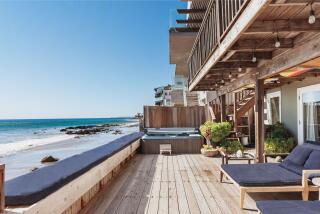At an age when luxury can’t hide the future
For months after she moved into Belmont Village, Meril Graf couldn’t unlock the door to her penthouse apartment without crying.
When she got inside, “all I would do was nap,” she said. When her children tried to talk up the place — maid service, gourmet meals and endless social amenities — she listened, stone-faced, “with tears running down my cheeks.”
“I didn’t want to be here,” Graf recalled. “I didn’t want this to be happening to me.”
We were sitting on the sofa in her elegant, sunny living room, with a wall of windows looking out over Wilshire Boulevard six floors below. I couldn’t imagine mourning over a move into such luxury digs. No cleaning or yard work or meals to cook. No blaring music or barking dogs.
That seems like nirvana for a middle-aged empty nester wannabe, like me. But for residents, a “senior living community,” even one as nice as Belmont Village, might seem more like a floor plan for life’s final descent, from Independent to Assisted Living; from Memory Enrichment Program to Dementia Village.
Its luxury makes the journey comfortable, but a gilded path can’t obscure the route through infirmity and senility, to the cemetery.
::
Belmont Village represents the new wave of retirement homes, more Ritz-Carlton than classic board and care.
There’s a gourmet menu in Josephine’s Kitchen; a library, beauty salon, pool and spa; a bistro for happy hour. The gym is the “Center for Life Enhancement.” The clubhouse is the “Learning Center.”
Weekly lectures by retired UCLA professors range from “Sex and Religion” to “The Why and How of WWII Aircraft.” Medical talks are popular: “Balance and Fall Prevention,” “Co-enzyme Q, Vitamin E, Fish Oil and You!” But so are the annual fashion show and Champagne Courtyard Cabaret.
The good life doesn’t come cheap. Belmont’s least expensive apartment — including meals, social events and a 24-hour nurse — goes for $5,175 a month. In the assisted-living corridors, rent tops out at more than $12,000. The 168-unit complex is a stone’s throw from UCLA; a third of its residents are former university staffers.
Graf, who once managed the database at UCLA’s oncology program, appreciates how lucky she is in an era when so many elderly men and women are forced to survive on donated food and thrift store castoffs.
“This is a lovely place, and I’m not complaining,” Graf told me when I visited her women’s group meeting this week. “I’m very fortunate to be here. I’m very fortunate to be married. And I know this was the best thing to do.”
Her husband can no longer drive and uses a walker. She was hospitalized this year for heart surgery. So many health problems were cropping up that her days had become a blur of trips to the doctor, the pharmacy and the market.
Still, she misses her former life, in a condominium three blocks from the beach in Marina del Rey. It’s hard for her to talk about the painful process of downsizing, parceling out 34 years of memories.
“My sister and I had to go through her closet with her,” recalled her daughter Nancy McKinney. “She couldn’t figure out what to give away. We held each outfit up and made three piles: yes, no, or maybe.”
I know that ritual well myself. Every year I went through it with growing daughters. Only then mom was the one building piles, and the children were trying to hold back time.
::
Graf gripes about her tiny kitchen, with no dishwasher or counter space. It pained her to have to send out for a bucket of fried chicken last summer when her children and their children crammed into her new place.
But her daughter sees security, not loss. A driver ferries mom to the market, unloads her groceries and carries them up. Each room in the new apartment has an emergency pull cord to summon a nurse if something goes wrong.
As I listen to them, I think of the joke my daughter used to toss off when I worried about paying tuition at Stanford. The investment would pay off for me, she’d say. “Because I’ll get a high-paying good job, and be able to afford to put you in a really nice retirement home.”
It doesn’t seem so funny now. “Nice,” I realize, can be cold comfort, when you’ve lost the roses outside your door, the neighbor whose banana bread you loved and the wind chimes that lulled you to sleep on breezy evenings.
I can imagine myself in Graf’s shoes, wondering, as she said to me, “What happened to the last 30 years?
“I look in the mirror, and I see it, but I don’t ‘feel’ old,” she said. “Until I look at everybody else living here with me.”
Some of what she sees is comforting, like the “adorable couple” — he’s 96 and she’s 93 — who still hold hands in lip-reading class. And she has no shortage of friends nearby; many Belmont residents are people she has known for years.
But if all the classes and outings and socializing are supposed to make the elderly feel young, sometimes they tug in the other direction.
“Reminders of your own aging are everywhere,” Graf said. In the rambling interruptions of a speaker’s lecture, and the wanderings of a resident who got lost in the hallway and fell asleep in a neighbor’s bed.
It’s an unsettling peek into an uncertain future. “You sit down with people in the dining room who may not remember that they had dinner with you the night before.”
“It’s scary,” she said. “And you can’t avoid it. You meet your own mortality.”





